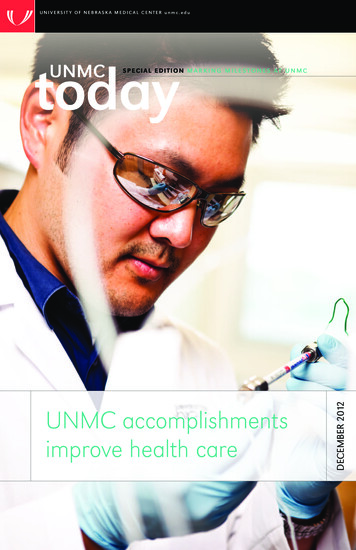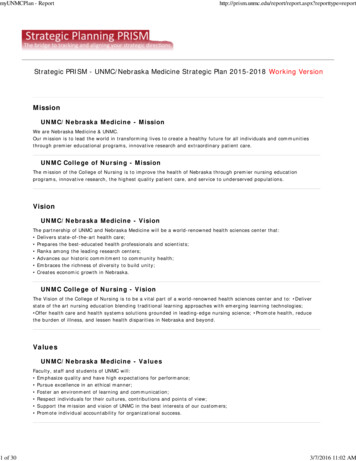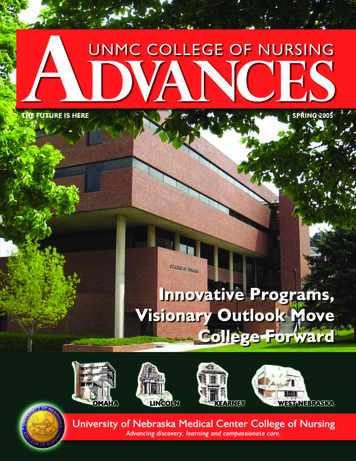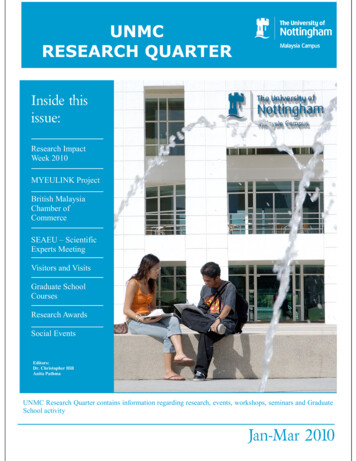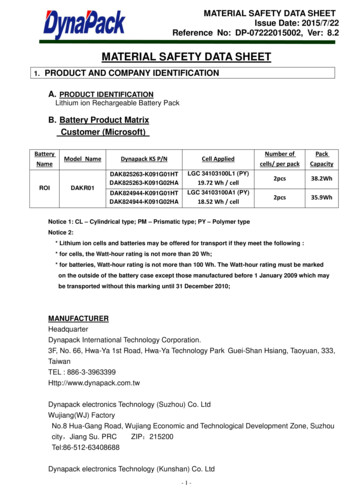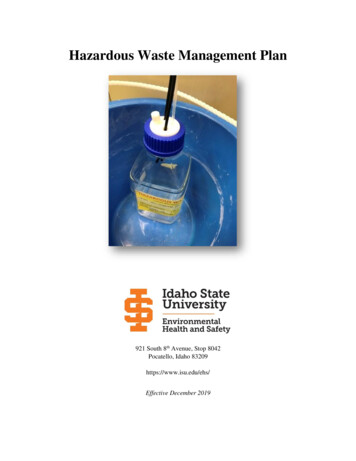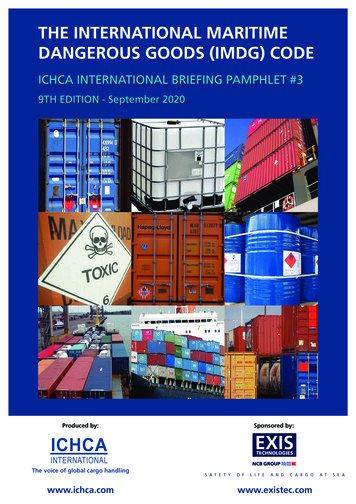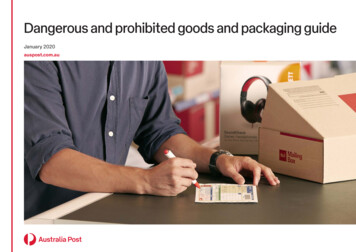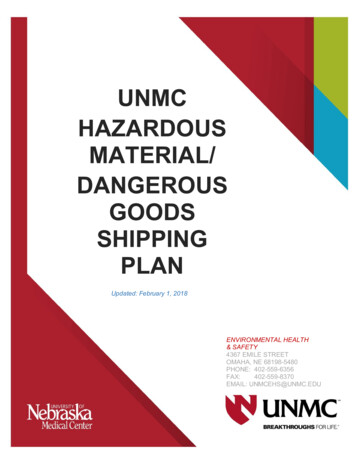
Transcription
dated: February 1, 2018ENVIRONMENTAL HEALTH& SAFETY4367 EMILE STREETOMAHA, NE 68198-5480PHONE: 402-559-6356FAX:402-559-8370EMAIL: UNMCEHS@UNMC.EDU
Hazardous Material/Dangerous Goods (HM/DG)Shipping PlanBasis for the planThe shipment and transport of Hazardous Materials / Dangerous Goods is a serious matter andrequires University of Nebraska Medical Center (UNMC) and Nebraska Medicine (NM)compliance with Department of Transportation (DOT), International Air Transport Association(IATA) and Transportation Security Administration (TSA) regulatory requirements.The Department of Transportation (DOT) in Title 49 of the Code of Federal Regulations (CFR)regulates and provides instructions for all modes of transportation. In addition, the InternationalCivil Aviation Organization (ICAO), International Air Transport Association (IATA), imposes morestringent requirements for air transportation by providing technical instructions. Violations ofthese regulations may result in fines as follows:(a) A person who knowingly violates a requirement of the Federal hazardous materialstransportation laws, an order issued thereunder, subchapter A or C of chapter I, subtitleB, of this title, or a special permit or approval issued under subchapter A or C of chapterI, subtitle B, of this title is liable for a civil penalty of not more than 78,376 for eachviolation, except that—(1) The maximum civil penalty for a violation is 182,877 if the violation results indeath, serious illness, or severe injury to any person, or substantial destruction ofproperty and(2) A minimum 471 civil penalty applies to a violation related to training.(b) When the violation is a continuing one, each day of the violation constitutes aseparate offense. 49 U.S.C. 5123.Export Control of Hazardous Material/Dangerous GoodsHM/DG, which could include chemicals, chemical kits, patient specimens, blood samples,rechargeable batteries (lithium, etc.), pharmaceutical products and biological specimens, thatare being shipped internationally, may be regulated under the export control federalrequirements. Shipments of these materials require an export control evaluation prior toshipment. Please see the attached Export Control Policy.DefinitionsHazardous Materials (HM) are substances or materials which can pose an unreasonable riskto health, safety, and property when transported in commerce, by ground or air, and which havebeen so designated by the DOT. The term includes hazardous substances, hazardous wastes,marine pollutants, and elevated temperature materials as defined, materials designated ashazardous under 49 CFR 172.101, and materials that meet the defining criteria for hazardclasses and divisions in 49 CFR Part 173.Dangerous Goods (DG) are defined as those goods which meet the criteria of one or more ofnine hazard classes or are articles or substances which are capable of posing a significant riskto health, safety or to property when transported by air and are classified by ICAO or IATA.
Hazard Classes are categories of hazards which are assigned to HM/DG. All regulated materialwill fit within one of the classes1.2.3.4.5.6.7.8.9.ExplosivesGasesFlammable liquidsFlammable solidsOxidizing substancesToxic chemicals and Infectious substances.Radioactive materialCorrosivesMisc.Hidden Dangerous Goods. Products may contain Dangerous Goods which are not readilyapparent. If you are shipping any of the following please contact EHS for further determination. Electronic products, mobile phones and accessories, photographic equipment,torch/flashlight, dry batteries, lithium batteries, prototype lithium batteries,rechargeable batteries, wet cell batteries, alkaline batteries, batteries contained inequipment, speaker, solar charger or ultra-capacitor.Personal care products, cosmetics, perfume, nail polish, household chemicals,cleaning agents, aerosols, bleach, drain cleaners, pesticides, wax, toolbox, glue,spray paint, lubricants, lighter fluid.Motor vehicles, motorcycles or electric vehicles parts, engines, lawn mowers,generator, carburetor, fuel tank, fuel, fuel controllers, fire extinguishers, air bag, shipsor aircraft parts, barometers.Agricultural or industrial chemicals, chemicals with strong odor or volatile chemicals,metal powder, pigment, flammable solids, oxidizers, toxic or corrosive substances,pesticides, compressed gases, flammable liquids, resins, inks, paints, sealants,adhesives, mercury.Medical equipment, radioactive substances, pharmaceuticals raw materials, vaccinesor virus samples, compressed gases, cryogenic liquefied gases, dry ice,sphygmomanometer, thermometers.Electrical appliances, refrigerators, air conditioners, vacuum tube, magnetic tubes,magnets, smoke detectors.Aviation Regulated Solids or Liquids are any material, which has narcotic, noxious, irritatingor other properties such that, in the event of spillage or leakage on an aircraft, could causeextreme annoyance or discomfort to crew members so as to prevent the correct performance ofassigned duties.Chemicals are transported to, from and within UNMC for a variety of reasons. This can includesending chemicals to collaborating universities or companies, returning products tomanufacturers, faculty shipping chemicals off-site to other institutions when accepting a newposition, and when laboratories move from one building to another on-site.Please contact EHS for guidance in determining which chemicals are regulated by DOT orIATA. Chemicals that are not regulated may be shipped by the employee. Chemicals that areregulated must be shipped by EHS. UNMC/NM employees, or their departments are responsiblefor all costs associated with transporting chemicals.
Dry ice (Carbon dioxide, solid) is listed as a dangerous good by IATA and DOT when shippedby air. Therefore, when dry ice is shipped by air, as a refrigerant for dangerous and nondangerous goods, it must be packaged in accordance with IATA and DOT regulations.Infectious substances are substances which are known or are reasonably expected to containpathogens. Pathogens are defined as micro-organisms (including bacteria, viruses, rickettsia,parasites, fungi) and other agents such as prions, which can cause disease in humans oranimals.o Category A: An infectious substance which is transported in a form that, whenexposure to it occurs, is capable of causing permanent disability, life threatening orfatal disease in otherwise healthy humans or animals. Infectious substancesmeeting this criteria which causes disease in humans or both humans and animalsmust be assigned to UN2814, Infectious substance, affecting humans. Infectioussubstances which cause disease only in animals must be assigned to UN2900,Infectious substances, affecting animals.o Category B: An infectious substance which does not meet the criteria for inclusioninto Category A. Infectious substances in Category B must be assigned asUN3373, Biological substance, Category B.o Patient specimens are those collected directly from humans or animals, includingbut not limited to excreta, secreta, blood and its components, tissue and tissuefluid swabs and body parts, being transported for purposes such as research,diagnosis, investigational activities, disease treatment and prevention. Exempthuman or animal specimens are patient specimens for which there is minimallikelihood that pathogens are present are shipped as “Exempt human Specimen”or “Exempt animal specimen”.o Cultures are the result of a process by which pathogens are intentionallypropagatedo Regulated Medical Waste or clinical waste or (bio) medical waste means a wasteor reusable material derived from the medical treatment of an animal or human,which includes diagnosis and immunization, or from biomedical research, whichincludes the production and testing of biological products. Regulated medicalwaste or clinical waste or (bio) medical waste containing a Category A, Infectioussubstance must be classed as an infectious substance, and assigned to UN2814or UN2900, as appropriate with excepted quantity of a chemical constituent.Radioactive Material means any material containing radionuclides where both the activityconcentration and the total activity exceeds the values specified in 10.3.2 of the IATADangerous Goods Regulations or the table in 173.436 of the DOT regulations. Contact EHS ifyou wish to transport radioactive material.Newly synthesized pharmaceutical/chemical products may contain hidden DangerousGoods. As these do not have existing Safety Data Sheets (SDS), they must be evaluatedbased on their chemical characteristics. Please see the Dangerous Goods DeterminationChecklist. If these are part of an export control review, the checklist is already included in theexport control process. If not exported and offered for domestic shipment by air or ground, callEHS at 96356 for help.Excepted Quantities are small quantities ( 30g or 30ml) of hazardous materials that mayqualify for reduced shipping requirements. At UNMC, this may be samples preserved in ethanol
or other flammable liquid, or could be test kits, or chemicals in general, may be toxic, oxidizing,corrosive material.Select Agents are biological agents and toxins that have been determined to have the potentialto pose a severe threat to public health and safety, to animal and plant health, or to animal orplant products. 42 CFR Part 73 requires laboratories to be registered by the U.S. Department ofHealth and Human Services before they can possess, transfer, or receive select agent ororganisms or chemical toxins. To comply with this federal mandate, any laboratory consideringthe transfer or receipt of these agents must first contact the UNMC Biosafety Officer, ext. 9-7774for guidance on registration and shipment requirements.ResponsibilitiesUNMC Environmental Health and SafetyUNMC Environmental Health & Safety Department (EHS) is the point of contact for shipping allhazardous material or dangerous goods. EHS personnel are trained to ship all hazardousmaterials and dangerous goods. EHS can provide training to other UNMC/NM personnel on DryIce, Excepted Quantities and Infectious Substance and will assist in shipping all otherhazardous materials or dangerous goods. EHS will meet with, escort, and correspond with FAAor DOT agents if they arrive on campus.UNMC/NM Personnel wishing to ship Hazardous Materials/Dangerous Goods offsite.UNMC/NM personnel must not ship a HM/DG without first contacting EHS. If training is availablefor the HM/DG they wish to ship, EHS staff will provide training information. Personnel mustmeet all the training requirements (initial or recurrent) before shipping, and must follow all rulesand regulations. If training is not available, EHS will help to coordinate shipping.UNMC/NM Personnel wishing to ship Hazardous Materials/Dangerous Goods onsite.UNMC/NM personnel can move HM/DG including chemicals from building to building usingcarts as long as all material is packed compatibly, by hazard class, in sturdy closed containersor boxes. Contact EHS with any questions or for more guidance.Transportation Companies or Couriers contracted to transport HazardousMaterial/Dangerous Goods, including patient specimensUNMC/NM Departments may hire outside contractors to ship HM/DG provide they have beenapproved by EHS. These transportation companies and couriers must be knowledgeable ofIATA, DOT regulations and meet all necessary requirements in the proper packaging,paperwork, handling and transportation of all hazardous material. Couriers transporting ambient,refrigerated and/or frozen specimens must also be compliant with OSHA, TSA and HIPAAregulations. Specimen couriers should provide specimen transport coolers, spill kits andidentification badges. Note: Most moving companies are not certified to transport hazardousmaterialsUNMC/NM employees transporting hazardous material in company vehiclesUNMC/NM employees that transport dangerous good/hazardous materials in UNMC ownedvehicles are subject to DOT hazard awareness training. Please contact EHS for training.
Radioactive material cannot be transported in vehicles. Contact EHS if you need to ship anyradioactive material.UNMC/NM employees transporting hazardous material in personal vehiclesUNMC/NM employees may use a personal vehicle to transport exempt human or animalspecimens for routine testing provided they have been trained and certified and equipped withspecimen transport coolers and spill kits. These specimens can be transported ambient, withcold packs or dry ice.UNMC/NM personnel must have approval by EHS to transport chemicals, or specimens that areknown, suspected, or are to be tested for Category A or B Infectious substances in a personalvehicle.If you have an accident/incident involving a shipment, please complete the Incident/AccidentReporting Form.TrainingTraining is available through EHS for UNMC/NM employees who ship certain HM/DG includingExcepted Quantities, Dry Ice and Infectious Substances (Biological substance-Category A,Biological substance- Category B, Diagnostic Specimens, and Regulated Medical Waste).Training is also available for UNMC/NM employees who accept hazardous materials ortransport hazardous materials as part of their job. This training can be scheduled by contactingEHS at ext. 9-6356 or 9-2737. If you wish to ship any other hazardous material/dangerous good,please contact EHS for assistance.Training will be in accordance with 49 CFR 172 Subpart H and IATA requirements. Recurrenttraining is required every two years. To ensure compliance with the regulations training willcover General Awareness, Function Specific, Safety and if required in-depth Security training. Ata minimum it will consist of: Applicability to regulations Limitations Classifications Identification Packaging Packing specifications and performance tests Marking and labeling Documentation Security AwarenessEmployees are required to review the training material, pass a test, and attend an inclass training (for initial certification) prior to receiving a certificate of completion.Additional information for trained and certified personnel
1. Trained and certified personnel must ship packages of HazardousMaterial/Dangerous Goods through Mail Services/General Supply, or makearrangements with other couriers to have material picked up from their location.2. Certified shippers who offer a Category A Infectious substance package fortransport must follow the special handling security requirements as outlined inUNMC-IBC30. Please consult this policy prior to shipment. For questionsregarding this policy, call Pete Iwen, PhD at 559-7774. Category A dangerousgoods can be shipped but must be hand carried to General Supply or MailServices. They cannot be left at a drop off location.3. Only UN certified shipping containers that comply with the specific hazard, shallbe used when shipping regulated material. A package performance testcertification, and closure instructions for each type of container used, must bekept on file by the individual shipper and will be audited for compliance.4. Trained and certified personnel who offer a hazardous material/dangerous goodfor transportation must provide an emergency response telephone number, ifrequired, (including the area code or international access code) for use in theevent of an emergency involving the hazardous material. UNMC has registered with CHEMTREC to provide an emergency responseinformation. All UNMC/NM shippers will use the CHEMTREC telephonenumber (800) 424-9300 as the emergency contact number for domesticshipments. If the package is shipped outside the USA and needs an emergency responsenumber, please contact EHS for guidance.5. Certified shippers must keep a file of shipping documentation (air bills, shipper’sdeclarations, or bills of lading) for two years (domestic shipments) or five years(international shipments) after the acceptance of the material by the initial carrier.These copies must be available for inspection.6. All certified shippers should utilize the Dangerous Goods Checklist and InfectiousSubstance and Dry Ice Shipping Examples when preparing packages andpaperwork. Failure to complete all the steps could result in your package gettingrejected. Rejected packages, paperwork and the corresponding corrections, arethe responsibility of the shipper of record.7. UNMC Environmental Health & Safety will conduct annual audits of all shippers toverify compliance with the regulations. The audit will include an inspection oftraining records, packaging and package certifications, shipping papers andretention of paperwork.
The term includes hazardous substances, hazardous wastes, marine pollutants, and elevated temperature materials as defined, materials designated as . waste or clinical waste or (bio) medical waste containing a Category A, Infectious substance must be classed as an infectious substance, and assigned to UN2814 or UN2900, as appropriate
